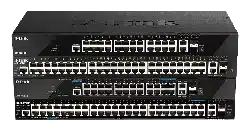Loading ...
Loading ...
Loading ...

DGS-1520 Series Gigabit Ethernet Smart Managed Switch Web UI Reference Guide
104
To view the following window, click Management > Stacking > Stacking Bandwidth, as shown below:
Figure 4-87 Stacking Bandwidth Window
The fields that can be configured are described below:
Parameter Description
Stack Bandwidth
Select the stacking bandwidth here. Option to choose from are:
• 2-Port-SFP+ - Specifies to use the two SFP+ stacking ports.
• 2-Port-10G-Base-T - Specifies to use the two RJ45 stacking ports.
• 4-Port-Hybrid - Specifies to use all the stacking ports.
Click the Apply button to accept the changes made.
Virtual Stacking (SIM)
D-Link Single IP Management (SIM) is a concept that will stack Switches together over Ethernet instead of using
stacking ports or modules. There are some advantages in implementing the Single IP Management feature:
• SIM can simplify management of small workgroups or wiring closets while scaling the network to handle
increased bandwidth demand.
• SIM can reduce the number of IP address needed in your network.
• SIM can eliminate any specialized cables for stacking connectivity and remove the distance barriers that
typically limit your topology options when using other stacking technology.
Switches using D-Link Single IP Management (labeled here as SIM) must conform to the following rules:
• SIM is an optional feature on the Switch and can easily be enabled or disabled through the Command Line
Interface or Web Interface. SIM grouping has no effect on the normal operation of the Switch in the network.
• There are three classifications for Switches using SIM. The Commander Switch (CS), which is the master
Switch of the group, Member Switch (MS), which is a Switch that is recognized by the CS a member of a SIM
group, and a Candidate Switch (CaS), which is a Switch that has a physical link to the SIM group but has not
been recognized by the CS as a member of the SIM group.
• A SIM group can only have one Commander Switch (CS).
• A SIM group accepts up to 32 Switches (numbered 1-32), not including the Commander Switch (numbered 0).
• Members of a SIM group must be in the same Layer 2 network.
• There is no limit to the number of SIM groups in the same IP subnet (broadcast domain); however, a single
Switch can only belong to one group.
• If multiple VLANs are configured, the SIM group will only utilize the management VLAN on any Switch.
• SIM allows intermediate devices that do not support SIM. This enables the user to manage Switches that are
more than one hop away from the CS.
Loading ...
Loading ...
Loading ...
